Food preservation includes food processing practices which prevent the growth of microorganisms, such as yeasts, and slow the oxidation of fats that cause rancidity. Food preservation may also include processes that inhibit visual deterioration, such as the enzymatic browning reaction in apples after they are cut during food preparation. By preserving food, food waste can be reduced, which is an important way to decrease production costs and increase the efficiency of food systems, improve food security and nutrition and contribute towards environmental sustainability. For instance, it can reduce the environmental impact of food production.

Cucumber is a widely-cultivated creeping vine plant in the Cucurbitaceae family that bears usually cylindrical fruits, which are used as vegetables. Considered an annual plant, there are three main varieties of cucumber — slicing, pickling, and burpless/seedless — within which several cultivars have been created. The cucumber originates from South Asia, but now grows on most continents, as many different types of cucumber are traded on the global market. In North America, the term wild cucumber refers to plants in the genera Echinocystis and Marah, though the two are not closely related.
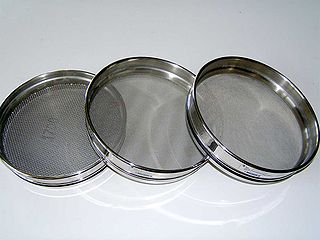
A sieve, fine mesh strainer, or sift, is a device for separating wanted elements from unwanted material or for characterizing the particle size distribution of a sample, using a screen such as a woven mesh or net or perforated sheet material. The word sift derives from sieve.
Tupperware is a home products line that includes preparation, storage, and serving products for the kitchen and home. In 1942, Earl Tupper developed his first bell-shaped container; the brand products were introduced to the public in 1946.
Earl Silas Tupper was an American businessman and inventor, best known as the inventor of Tupperware, an airtight plastic container for storing food, and for founding the related home products company that bears his name, Tupperware Plastics Company.
The throw-away society is a generalised description of human social concept strongly influenced by consumerism, whereby the society tends to use items once only, from disposable packaging, and consumer products are not designed for reuse or lifetime use. The term describes a critical view of overconsumption and excessive production of short-lived or disposable items over durable goods that can be repaired, but at its origins, it was viewed as a positive attribute.
Tupperware Brands Corporation, formerly Tupperware Corporation, is an American multinational multi-level marketing company. Its main focus is kitchen and household products, and it is particularly known for its line of plastic containers for food storage and preparation. By extension, plastic food containers in general, regardless of brand, are often referred to as Tupperware.
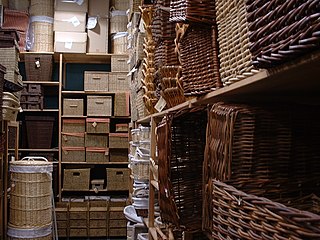
A hamper refers to one of several related basket-like items. In primarily British usage, it refers to a wicker basket, usually large, that is used for the transport of items, often food. In North America, the term generally refers to a household receptacle, often a basket, for clean or dirty clothing, regardless of its composition, i.e. "a laundry hamper". Typically a laundry hamper is used for storage and will be sturdier, taller and have a lid while a laundry basket is open and used mainly for transport.
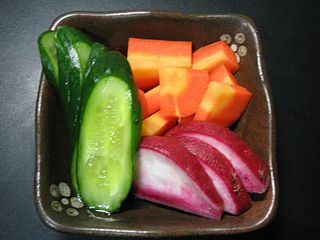
Nukazuke (糠漬け) is a type of Japanese preserved food, made by fermenting vegetables in rice bran (nuka), developed in the 17th century.

A flexible intermediate bulk container (FIBC), jumbo, bulk bag, super sack, big bag, or tonne bag is an industrial container made of flexible fabric that is designed for storing and transporting dry, flowable products, such as sand, fertilizer, and granules of plastic.
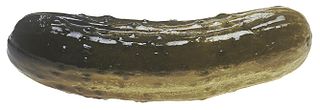
A pickled cucumber is a cucumber that has been pickled in a brine, vinegar, or other solution and left to ferment for a period of time, by either immersing the cucumbers in an acidic solution or through souring by lacto-fermentation. Pickled cucumbers are often part of mixed pickles.
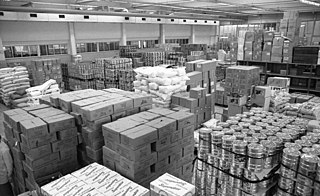
Food storage containers are widespread in use throughout the world and have probably been in use since the first human civilizations.

Disposable food packaging comprises disposable products often found in fast food restaurants, takeout restaurants and kiosks, and catering establishments. Food-serving items for picnics and parties are very similar. Typical disposable foodservice products are foam food containers, plates, bowls, cups, utensils, doilies and tray papers. These products can be made from a number of materials including plastics, paper, bioresins, wood and bamboo.

The Big N’ Tasty is a hamburger sold by the international fast food chain McDonald's. It is designed to compete with the Whopper sandwich. A similar variation called the Big Tasty, without the center "N'", which was first released in Saudi Arabia, is sold outside the United States in parts of Europe, South America, South Africa, The Middle East, and Taiwan.
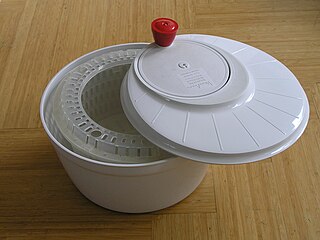
A salad spinner, also known as a salad tosser, is a kitchen tool used to wash and remove excess water from salad greens. It uses centrifugal force to separate the water from the leaves, enabling salad dressing to stick to the leaves without dilution.
Mrs. Schlorer's was the brand name for mayonnaise and numerous other food condiments originally manufactured by the Schlorer Delicatessen Company in Philadelphia, PA. Mrs. Schlorer's Mayonnaise is credited as being the first mayonnaise put in jars and sold commercially in 1907. The first products trademarked by the Schlorer Delicatessen Company were Mrs. Schlorer's Mayonnaise and Mrs. Schlorer's Olivenaise in 1917.
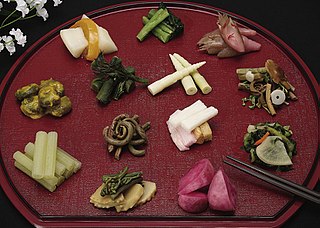
Tsukemono are Japanese preserved vegetables. They are served with rice as an okazu, with drinks as an otsumami (snack), as an accompaniment to or garnish for meals, and as a course in the kaiseki portion of a Japanese tea ceremony.

American Jewish cuisine comprises the food, cooking, and dining customs associated with American Jews. It was heavily influenced by the cuisine of Jewish immigrants who came to the United States from Eastern Europe around the turn of the 20th century. It was further developed in unique ways by the immigrants and their descendants, especially in New York City and other large metropolitan areas of the northeastern U.S.
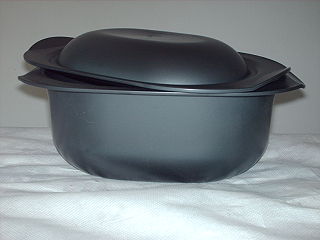
Plastic containers are containers made exclusively or partially of plastic. Plastic containers are ubiquitous either as single-use or reuseable/durable plastic cups, plastic bottles, plastic bags, foam food containers, Tupperware, plastic tubes, clamshells, cosmetic containers, up to intermediate bulk containers and various types of containers made of corrugated plastic. The entire packaging industry heavily depends on plastic containers or containers with some plastic content, besides paperboard and other materials. Food storage nowadays relies mainly on plastic food storage containers.













